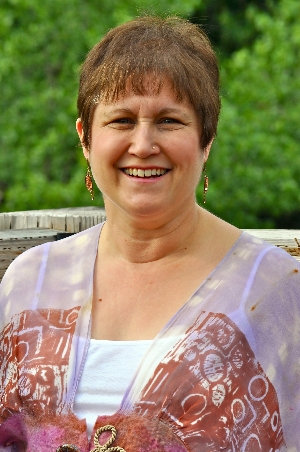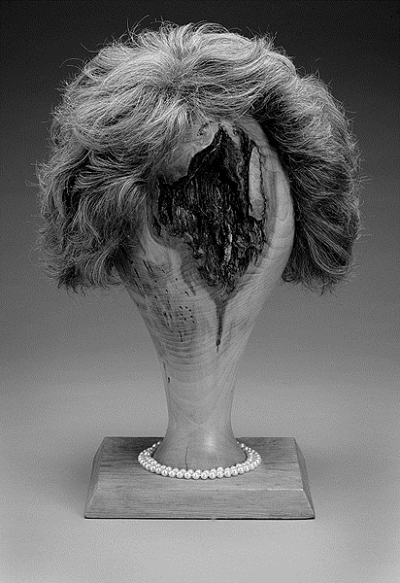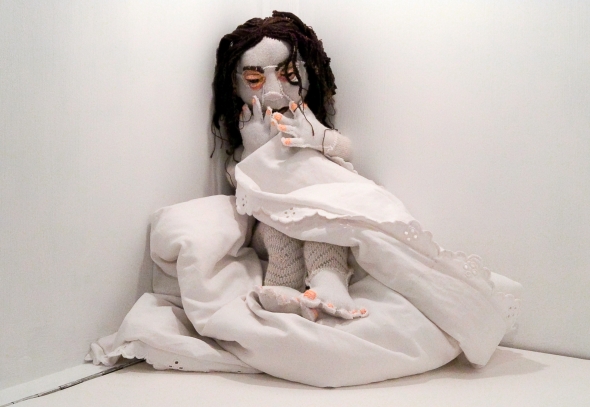 Ann Futterman Collier is a licensed Clinical Psychologist with many years experience of working with textile arts and therapy. She is a lecturer at the University of Wisconsin, teaching undergraduate and graduate courses in abnormal psychology, counseling techniques, health psychology, and art therapy theory; she also conducts research on the well-being of women who create with textiles. She resides in Eau Claire, Wisconsin.
Ann Futterman Collier is a licensed Clinical Psychologist with many years experience of working with textile arts and therapy. She is a lecturer at the University of Wisconsin, teaching undergraduate and graduate courses in abnormal psychology, counseling techniques, health psychology, and art therapy theory; she also conducts research on the well-being of women who create with textiles. She resides in Eau Claire, Wisconsin.
Using Textile Arts and Handcrafts in Therapy with Women: Weaving Lives Back Together
Can you tell us a bit about your experience – personally and professionally – with textiles, and what led you to explore the therapeutic uses of this medium?
I am mostly self-taught at fiber arts. I began creating with textiles when I was a child; it was my own interest, not something those around me knew much about. I taught myself to sew when I was 11. I apprenticed at a professional costume shop in a summer-stock theater beginning at 14; by the time I was 17, I was the lead dresser and had been offered a costuming job at a major theater company (which I turned down in order to attend college). I learned to weave at 21 and then began to make my own fabric to sew with. I wove my way through graduate school (Ph.D. in Clinical Psychology, University of California, Los Angeles), grounding myself in my tiny “loom-room” filled with colors and textures. Somehow, the hypomanic sleep deprivation caused by “creating” cloth until 4:00 am often gave me more energy, not less, to cope. The “making” of fabric revitalized, invigorated and transformed me.
Subsequently, every place I lived in or traveled to, I learned new textile techniques, typically from everyday people around me. I managed to transport my 54-inch counter-balanced loom to Micronesia, New Zealand, and then Alaska. I found a universal, non-verbal language to connect with women through textiles: from remote villages in Laos along the Mekong River, to small hamlets in rural Indonesia, to sheep farms in the far south island of New Zealand, to isolated Pacific atolls in Micronesia and Polynesia, to dirt pathways behind storefronts in Ubud, Bali. My training in textiles came from girls, young women, and old women all over the world; they taught me different ways to weave, shear sheep, felt, use a kajip, batik, spin and sew. And while I learned and watched, I created personal connections with strangers who had very little in common with me aside from our love of cloth. Ironically, as my fiber-making skills developed, my clinical skills also developed. I became better at creating relationships and more and more comfortable with using textiles as an entryway to connect with women whom I didn’t know. At some point, it became obvious to me that making textiles and clinical psychology didn’t need to be two separate compartments in my life: I realized that I was already integrating the two.
What motivated you to write this book and share your experiences of using textile arts in therapy?
Women all over the world make objects with fibers and textiles. Historically, textile-making has served a central and functional role for women. With the beginning of the Industrial Revolution, textile-making moved out of the home and into factories; eventually individual textile-making declined. This was further exacerbated as women in the 60’s and 70’s questioned and rejected stereotypic feminine constructs that they perceived as domestic and oppressive. Fiber arts were seen as uncreative, old-fashioned and ugly. Despite this denigration, there has been a renaissance in textile handcrafts since the early part of the 21st century. Labeled everything from the “craft revolution” to the “new generation of do-it-yourselfers,” the pendulum has swung back and they are now seen as more acceptable, creative, and worthwhile pursuits.
“Why this book?” The majority of art therapy books and journal articles emphasize the visual arts and expressive arts. Although these do theoretically include textiles and fiber-making, there are shockingly few studies and no books dedicated exclusively to the application of textiles in art therapy. Textile words, metaphors, and idioms are deeply engrained in the English language (e.g. “spinning a tale,” “a thread of discourse,” “to come unraveled,” “unveiling the techniques,” “interwoven lives,” “hanging by a thread,” “on pins and needles,” “wear and tear,” and “at loose ends,”). As such, they naturally avail themselves to symbolically describe our inner psychological and outer social lives and can be used to explore key issues. And, in the every-day making of textiles, women cope with their lives, they keep their spirits uplifted. This book provides suggestions about how to use the metaphors and idioms already entrenched in textile arts, therapeutically. It also provides the clinician with a framework for how to explore textile-making in therapy. Finally, in my experience, multiple psychological issues can and do arise while taking fiber-related workshops – which many women (and men) take. Most artists (other than art therapists) are not trained in how to deal with these issues. I also wrote this book for them; to help fiber artists understand the processes that may be triggered in women when creating with textiles.
Why are textiles and fibers such effective media to use when working with women in particular? Can your approach be used with men?

They are an effective starting point because many women already know how to use multiple kinds of textile techniques (e.g. knitting, crocheting, weaving, spinning, sewing, embroidery, beading, rug hooking, felting, etc.), and, because many women already use them this way. For example, last summer I crocheted a sweater while my friend was dying; all of my pain and her pain were absorbed into the sweater during the time I was with her. The sweater became more than an object of distraction or of beauty. It became an object that held memories of my feelings and it captured precious yet difficult moments shared in time.
I recently published a study using a sample of almost 900 women across the USA and the Pacific Rim. From my research, I can honestly say that if you know how to use textile mediums, it will be one of the best activities you can use to rejuvenate and repair a bad mood. If you don’t tend to use fiber-making that way (e.g. instead you go for a walk, listen to music, call a friend) you will probably fare better, emotionally, by working on a textile project!
I chose to focus on women in the book because fiber-making is so embedded in our history, and because most women have some degree of skill in textile handcrafts. I also focused on women to simplify the psychological issues that would be discussed in the book, and because internationally, women have poorer mental health than men do (especially reflected in the incidence of depression, anxiety, PTSD, and certain personality disorders). However, I agree that art-making using one’s preferred medium has therapeutic value regardless of gender and regardless of the medium! Yes, I believe that the benefits of textile making are applicable to men as well. Especially if that man was already a textile handcrafter!
How does the book reflect your general philosophy about health and happiness?
About 10 years ago, I noticed something interesting in my textile-making: as I made handcrafts, I was transformed into a better “mental” place. Whether I spent hours, days, weeks, or months on a project, I always seemed to feel rejuvenated, energized, and restored afterwards. What is more, I found that I was better able to cope with life, to put adversity into perspective, and to stop ruminating.
About five years ago I began to wonder about this from a research perspective. Although I knew that textiles helped me to cope, my theory was that any leisure activity that was energizing, absorbing, and engaging, should lead to rejuvenation and hence positive mood repair. My preliminary research (together with my colleague Dr. Catya von Karolyi) has suggested that there are indeed multiple mood changing activities available for us to use, such as listening to music, exercising and talking to friends. The more engaging and energizing these activities are, the more they can positively change mood and result in rejuvenation. Going back to my textile research, the more arousing the fiber-making activity was (weaving and quilting were rated as the highest), the more effective it was at mood repair and rejuvenation. Thus excitement about fibers, mentally challenging and engaging textile projects, and even the movement associated with making textiles, all appear to be good for your mental health!
Art therapy classically emphasizes psychodynamic and psychoanalytic approaches; this typically encourages the person to express and vent negative feelings through their artwork. My approach uses art-making somewhat differently: it is seen as a way to bring about positive mood, pleasure and rejuvenation. I believe that this, in turn, reinforces the continuation of textile-making, which subsequently promotes more positive mood and coping. The book also shows how textile art-making can be taken to an entirely new level: building and constructing metaphorical objects in order to explore issues in more depth.
In the book you provide a whole range of practical textile-based projects that are tailored to key issues that crop up in therapy with women. Can you give an example and explain why it works so well?
The reader will find a variety of psychosocial issues matched with corresponding archetypes, metaphors, myths, and symbols, as well as fiber materials and objects. I was careful not to write a formula book – i.e. use this technique and these materials to resolve these problems. Instead, you will find a natural pairing of psychological issues with topical metaphors, textile metaphors, and object metaphors. I strongly encourage the reader to tailor these projects to accommodate the client’s skills, interests, religious or spiritual beliefs, cultural background, disability, previous expertise, and issues. I also suggest ways to use expressive writing and guided imagery to expand this exploration.
For example, one series of projects I suggest in the book is associated with healing emotional scars. The suggested object to make is healing (or prayer) shawls; the metaphors are the archetypal healer (e.g. Akesco, the Greek Goddess of healing wounds and curing illness) and scar tissue. Scars provide an amazing metaphor for our lives: We learn, we grow, and we get hurt. And we must learn to “defend” ourselves while we heal. Some of us respond to injury excessively; we produce tough scars that act as barriers and involve complicated networks of defense. Some of us shut down completely, the scar walls so strong and high that nothing can get through. Shawls are beautiful pieces of clothing. They also embrace, envelop, wrap, shelter, and give us comfort. Materials used to create shawls can vary from nuno felting or laminate felting (which can look a lot like scars) to crochet, but they all create a web, similar to the scar. Used this way, the making of the shawl can metaphorically transform the image of the scar into one of healing.
The book also includes vignettes about textile artists – can you tell us a bit about these?
During the time that I was doing research for this book, I kept coming across remarkable fiber artists who seemed to deeply understand the opportunity for expression that textile mediums allowed. They seemed to “get it,” how the metaphors and psychological issues could be integrated with the mediums and the objects. I would often stop in my tracks to examine their work with reverence and ponder at how startlingly expressive they were, and think wouldn’t “this piece” or “that piece” be a magnificent example for my book?

Eventually, it dawned on me to ask them if I could use their pictures. They were thrilled to participate; it was like singing to the choir. The textile artists were each selected because their artwork is brilliantly metaphoric; their preferred mediums are textile-based; they are female; and they are psychologically sensitive to both their own internal processes and to those of their students.
How should this book be used?
The book was originally intended for mental health professionals, and its theoretical orientation is mostly geared towards people who already have background knowledge and training in counseling (e.g., counselors, psychologists, occupational therapists, art therapists, expressive art therapists, recreational art therapists). It can also be used for fiber/textile art teachers who want to gain more of an understanding about psychological processes in themselves and their students. This book will also be useful to the individual textile handcrafter who wants to explore personal issues via textiles, in more depth.
Copyright © Jessica Kingsley Publishers 2012.
I learned of Ms. Collier’s article on “Textile Therapy” couple of years ago and got very happy and excited to learn that a Clinical Psychologist was making studies on the emotional benefits of Arts and Crafts activities. I am a psychologist by profession, and since I learned crochet, I discovered the soothing and relaxing effect it has in my body and mind (I call it “Crochet Therapy”). Since I discovered that this activity helped me emotionally, I committed myself to search for studies on the area; that’s why I got interested in Ms. Collier’s study and findings. I have experienced First Hand the emotional Benefits of making Handcrafts!! In my childhood, I was around family members that did sawing, embroidery and crochet. However, even though I learned a little bit of, especially embroidery, I never saw or did crochet. I thought that those activities were not for me; I thought that I did not have the artistic talents to do Handmade. About 4 years ago I was “placed” in the right place at the right time when I saw an old family friend crocheting. At that exact time I was touched by the Peace and Joy of Crochet! (It delighted me to see how from a piece of thread a small flower could be created!). I practiced and practiced crochet for four years now, and I have experienced how many of my own physical and mental disturbances have been alleviated from anxiety, attention/ concentration deficit, mild depression, etc. I do crochet every day and, I am convinced that this is one of the best “Relaxation techniques” one can ever use! I am also committed to spread these benefits to others that might find inspiration on learning these kinds of activities as techniques for stress reduction and relaxation.
I am working with ex con women in Israel and am finding the book mind opening in my rehabilitation work with them. I would very much appreciate making contact with Ann Collier and would like to know if she is running any workshops or courses that I could attend. If not I wonder if she would be open to having some email correspondence with me to support the challenging work I am doing.
Thank you.
Hi Yael, I have passed your message on to Ann and will let you know her reply. Best wishes, JKP